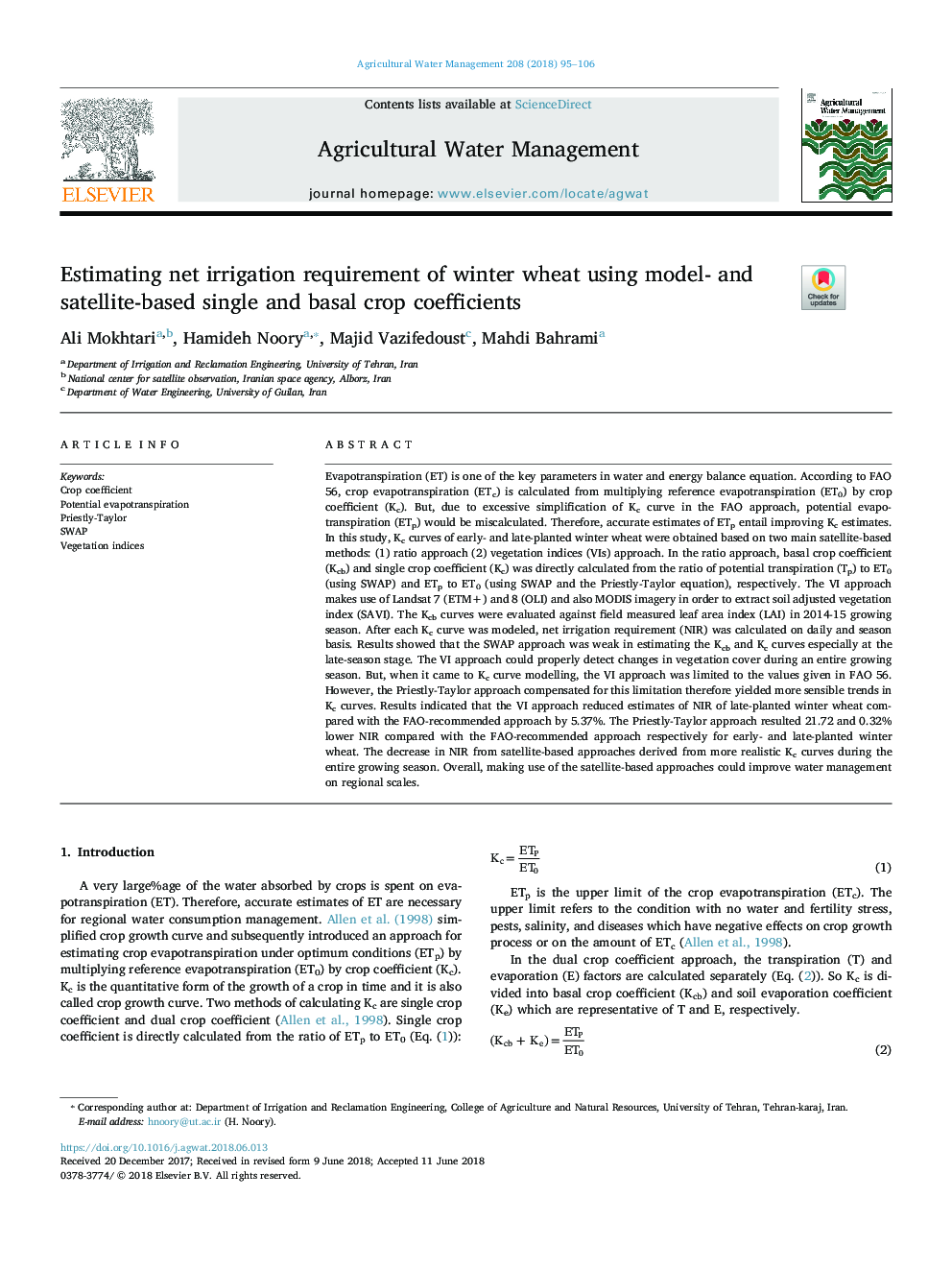| کد مقاله | کد نشریه | سال انتشار | مقاله انگلیسی | نسخه تمام متن |
|---|---|---|---|---|
| 8872756 | 1622872 | 2018 | 12 صفحه PDF | دانلود رایگان |
عنوان انگلیسی مقاله ISI
Estimating net irrigation requirement of winter wheat using model- and satellite-based single and basal crop coefficients
ترجمه فارسی عنوان
برآورد نیاز آبی خالص گندم زمستانه با استفاده از ضرایب تک و پایه گیاهی مدل و ماهواره ای
دانلود مقاله + سفارش ترجمه
دانلود مقاله ISI انگلیسی
رایگان برای ایرانیان
کلمات کلیدی
موضوعات مرتبط
علوم زیستی و بیوفناوری
علوم کشاورزی و بیولوژیک
علوم زراعت و اصلاح نباتات
چکیده انگلیسی
Evapotranspiration (ET) is one of the key parameters in water and energy balance equation. According to FAO 56, crop evapotranspiration (ETc) is calculated from multiplying reference evapotranspiration (ET0) by crop coefficient (Kc). But, due to excessive simplification of Kc curve in the FAO approach, potential evapotranspiration (ETp) would be miscalculated. Therefore, accurate estimates of ETp entail improving Kc estimates. In this study, Kc curves of early- and late-planted winter wheat were obtained based on two main satellite-based methods: (1) ratio approach (2) vegetation indices (VIs) approach. In the ratio approach, basal crop coefficient (Kcb) and single crop coefficient (Kc) was directly calculated from the ratio of potential transpiration (Tp) to ET0 (using SWAP) and ETp to ET0 (using SWAP and the Priestly-Taylor equation), respectively. The VI approach makes use of Landsat 7 (ETM+) and 8 (OLI) and also MODIS imagery in order to extract soil adjusted vegetation index (SAVI). The Kcb curves were evaluated against field measured leaf area index (LAI) in 2014-15 growing season. After each Kc curve was modeled, net irrigation requirement (NIR) was calculated on daily and season basis. Results showed that the SWAP approach was weak in estimating the Kcb and Kc curves especially at the late-season stage. The VI approach could properly detect changes in vegetation cover during an entire growing season. But, when it came to Kc curve modelling, the VI approach was limited to the values given in FAO 56. However, the Priestly-Taylor approach compensated for this limitation therefore yielded more sensible trends in Kc curves. Results indicated that the VI approach reduced estimates of NIR of late-planted winter wheat compared with the FAO-recommended approach by 5.37%. The Priestly-Taylor approach resulted 21.72 and 0.32% lower NIR compared with the FAO-recommended approach respectively for early- and late-planted winter wheat. The decrease in NIR from satellite-based approaches derived from more realistic Kc curves during the entire growing season. Overall, making use of the satellite-based approaches could improve water management on regional scales.
ناشر
Database: Elsevier - ScienceDirect (ساینس دایرکت)
Journal: Agricultural Water Management - Volume 208, 30 September 2018, Pages 95-106
Journal: Agricultural Water Management - Volume 208, 30 September 2018, Pages 95-106
نویسندگان
Ali Mokhtari, Hamideh Noory, Majid Vazifedoust, Mahdi Bahrami,
